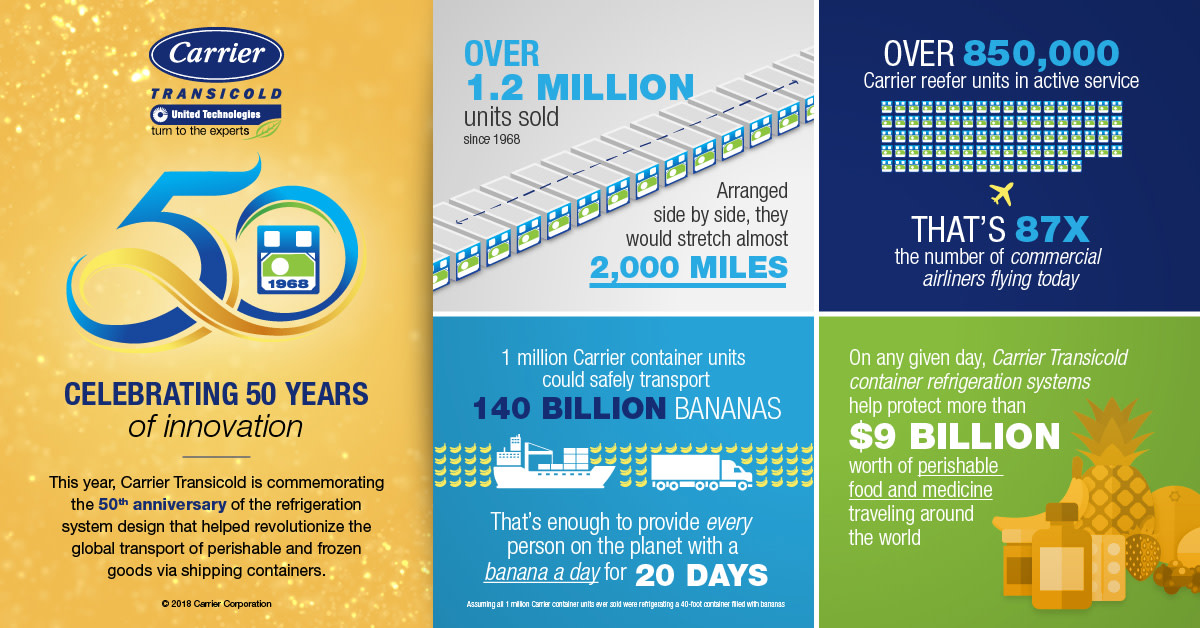
Often called a “picture frame” unit, the self-contained refrigeration system fit within a narrow steel frame, approximately 8 by 8.5 feet, that cleanly bolted to the front wall of an insulated shipping container. Introduced by Carrier in 1968, it quickly defined the shape of marine refrigeration systems for generations to follow.
“Our legacy of leadership is reflected in the golden anniversary of Carrier’s pioneering front-wall container refrigeration unit design,” said David Appel, president of Carrier Transicold & Refrigeration Systems.
“The design’s widespread adoption by the industry propelled expanded trade in refrigerated commodities, with an impact of helping to feed a growing global population by enabling the consumption of agricultural goods virtually everywhere, at any time,” Appel added
An Ideal Solution
Like so many great inventions before it, this one wasn’t appreciated or applied immediately. Carrier’s front-wall container refrigeration unit actually traces its origins to the rail industry where, in the 1950s, a bolt-on machine was proposed for sidewall mounting on rail cars. Although prototype machines were built and trialled with a Canadian rail line, the concept did not evolve, and plans were shelved.
But around that time, the container shipping industry was just taking shape in the United States when the Ideal X, a converted tanker, carried 58 trailer vans from Newark to Houston. Standardsized containers soon followed. Carrier engineers working in the Special Products Division in Syracuse, New York, recognized the opportunity and retrieved the rail unit plans, converting the narrowprofile electric refrigeration machine to fit the front wall of a steel shipping container.
Carrier’s original Frostmaster® models were the forerunners of today’s NaturaLINE® and PrimeLINE® units. Prior to 1968, ocean transport of refrigerated cargo primarily was the domain of dedicated vessels with refrigerated holds below deck. By providing a practical solution to refrigerating containers, Carrier added versatility and efficiency to the shipping process. Ultimately, refrigerated containers have enabled the quick loading and unloading of uniformly sized boxes, eliminating additional handling and transfers of perishable-laden pallets, as traditionally required.
Consider the Impact
The container shipping industry has grown exponentially to carry $4 trillion worth of goods annually, and nearly 80 percent of seaborne perishable cargo moves by refrigerated containers. Many of those containers are efficiently temperature-controlled by Carrier Transicold systems, of which more than 1.2 million have been sold.
Container refrigeration has improved and advanced over the years, and Carrier Transicold has led the industry with innovations to improve environmental sustainability, cargo protection, performance and efficiency.
Today, Carrier Transicold systems and worldwide network of more than 400 factory-authorized support locations play a significant role in helping to ensure the safe and reliable transport of produce, meat, seafood, vaccines and medicine from hemisphere to hemisphere, 24 hours a day, every day of the year.
“On any given day, Carrier Transicold container refrigeration systems help protect over $9 billion worth of refrigerated cargo traveling around the world,” Appel said. “We are grateful to our many customers for putting their trust in us these past 50 years and look forward with great anticipation to the next 50.”
A Legacy of Leadership
The picture frame system design jump-started refrigerated container trade and, over the years, Carrier Transicold has progressively advanced the technology with significant contributions to the industry. Here are just a few.
Refrigerant Evolution: The NaturaLINE® unit is the first and only container refrigeration system to use a natural refrigerant, which responds to today’s concerns about refrigerants with high global warming potential (GWP). It uses carbon dioxide (CO2) with an ultra-low GWP of 1. The efficient, closed-loop system also achieves deep-frozen temperatures of -40 degrees Celsius. Similarly, in the 1990s, following the Montreal Protocol agreement, Carrier Transicold led the industry in the conversion of container refrigeration systems to non-ozone depleting refrigerants.
Taking Control: XtendFRESH™ atmosphere control is the first system to manage oxygen and CO2 levels within a container, while simultaneously providing an integrated ethylene removal capability. The system helps extend shipping distances of perishables beyond what refrigeration alone can do and is a successor to Carrier Transicold’s pioneering EverFresh® system, which was the first integrated atmosphere control system for containers.
Pushing Efficiency: The PrimeLINE® unit introduced digital scroll compressor technology for use with the refrigerant R-134a, enabling higher efficiencies for reduced fuel consumption and emissions related to shipboard energy production. The PrimeLINE unit has outsold all competitive units for 10 years running.
